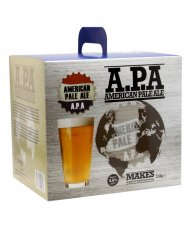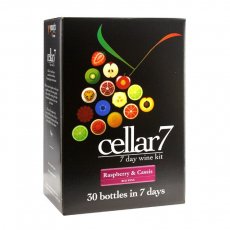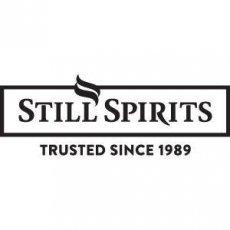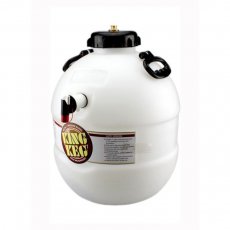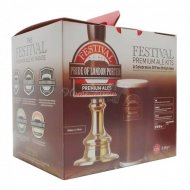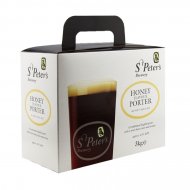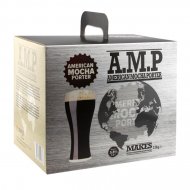Sign up to the Brew Mart newsletter for the latest news, offers & more
Home Brew Porter
If you want to brew your beer, a porter beer making kit is a great option. Many different home brew porter kits are available, so you can find one that fits your budget and experience level.
Porter Ale is a very dark hoppy porter first brewed in London during the 18th century. It was a favourite among the street and river porters, and it is thought that this is how it derived its name. Honey porter beer is a firm favourite among the home brew porters.
What makes a beer a porter beer?
Porter is the great-grandfather of today's stout.
Stout was, and still is, made with dark malted barley, a good amount of hops, and top-fermenting ale yeasts. The result is usually a dark medium-bodied beer with a nice balance of malty sweetness and bitter hoppiness.
Are Porter and stout the same?
The Beer Judge Certification Program describes a porter thus:
"A Porter is a substantial, malty dark beer with a complex and full of flavour dark malt character, whereas a stout described as being "fairly strong, highly roasted, bitter, hoppy and dark."
How do Porters taste?
Porters and stouts often have dark fruit flavours like dried cherries. You'll commonly taste coffee, toffee, and nuts. Bold cereal flavours like barley and oats will assert themselves. Like IPAs, caramel is also often a front-running taste.
London Porter beer is a beer style that started in London, England, in the early 1700s. It was dark in appearance due to brown malt and being well-hopped.
London porter originated from its humble beginnings of popularity with street and river porters.
The popularity of the porter beer style was significant, and it became the first beer style to be brewed across the world. By the end of the 1700s production, commenced in Ireland, North America, Sweden, and Russia.
The history of porter and stout go together.
The name "stout", mainly used for a dark beer, started because robust porters were referred to as "stout porter", later shortened to just being called stout. Guinness Extra Stout was initially named "Extra Superior Porter" and was not named "Extra Stout" until 1840.
Different breweries now use these terms to describe dark beers, and the two styles are hardly distinguishable from one another.
Porter in the 18th and 19th centuries.
In 1721 Porter beer was mentioned as a brew house-aged development of the brown beer already being produced across London. The beer was then delivered to publicans to age and blend it to their clienteles tastes.
Shoreditch brewer Ralph Harwood who worked from the Bell Brewhouse, initiated this practice.
Before 1700, London brewers delivered their beer very young to the pubs. The beers classed as Milds had then to be aged into Stale styles. Ageing the beers was performed by the publican or a dealer, with blends of Milds and Stales often sold to the public.
Porter beer was one of the first styles to be aged on the brewery premises and then dispatched in a condition fit to be drunk immediately. Porter was also a style capable of being produced on a large scale. The London porter brewers, such as Truman, Whitbread, Parsons and Thrale, achieved economies of scale and financial success.
Early London porter beers were a strong beer by today's standards. Early experiments with the hydrometer in the 1770s recorded Porter original gravity (OG) as 1.071 and 6.6% alcohol by volume (ABV).
The Napoleonic Wars increased taxation, causing brewers to lower the gravity to around 1.055, and it stayed like that for the rest of the 19th century. The popularity of the porter encouraged brewers to brew porters in a variety of strength from Single Stout Porter 1.066 OG, Double Stout Porter (such as Guinness) at 1.072 OG, Triple Stout Porter at 1.078, OG, Imperial Stout Porter at 1.095OG, and more.
During the 19th century, the porter suffix was gradually no longer used.
The large London porter breweries pioneered technological advances, such as the thermometer in 1760 and the hydrometer in 1770.
The use of the hydrometer transformed the nature of the London porter. The original porters were brewed from 100% brown malt. However, brewers could now accurately measure the yield from the malt they used using the hydrometer. The brewers noticed that brown malt only produced about two-thirds of fermentable material though cheaper than pale malt.
Brewers decided to use less malt when the malt tax increased to help pay for the Napoleonic Wars. The brewer's answer was to use a proportion of pale malt and add colouring to obtain the expected colour. Subsequently, a law was passed in 1816 allowing only malt and hops to produce beer, this made it very difficult for the brewers.
This problem was resolved by Wheeler's invention of the almost black (kilned) patent malt in 1817. Using the kilned malt, it was now possible to brew porter from 95% pale malt and 5% patent malt, although most London brewers continued to use brown malt for its flavour.
Until 1800, all London porter was matured in large vats, often holding several hundred barrels, for six to eighteen months. The porter was then racked into smaller barrels and delivered to the pubs. Ageing all of the porters was found not to be necessary as it was found that a small ammount of highly aged beer 18 months or more added to fresh or "mild" porter produced a flavour to that of aged beer.
It was a cheaper porter method, as the beer did not require storage for long periods. The usual mixture was two parts fresh beer to one part mature beer.
Towards the end of the 1800s, the popularity of London porter and the aged taste began to decline, and porter was now increasingly sold "mild". This decline caused many breweries to discontinue brewing porter, but they continued to brew stouts. Those breweries that continued with porter brewed it much weaker and with fewer hops. Between 1860 and 1914, the gravity reduced from 1.058 to 1.050 OG, and the hopping rate halved from two to one pound per 36-gallon barrel.
Porter during the 20th and 21st centuries
During the First World War in Britain, grain shortages led to restrictions on the strength of the beer. These rules were not as strict in Ireland, allowing Irish brewers to brew beers closer to pre-war recipes. English breweries did persist in brewing a range of bottled and draught stouts until after the Second World War. During the Second World War period, due to the Irish Free State's official policy of neutrality, this period was not technically considered wartime for them. Even so, Ireland suffered similar resource scarcities, resulting in rationing identical to the United Kingdom. Thus began a period of Emergency in Ireland, which affected breweries.
Porter beers became considerably weaker, which resulted in porters strength being the same as single stout. The sales of porter gradually declined, and production stopped in1941
The Anchor Brewing Company resurrected porter again in 1972, and the first batch was bottled in 1974. The resurrection of porter started a revival of the style, which began in 1978 when the Penrhos microbrewery introduced a porter to their range.
Timothy Taylor and Yorkshire started to brew a porter a little later. Today dozens of breweries in Britain are making porter.
Fuller's London Porter won gold and silver medals at the 1999, 2000 and 2002 International Beer and Cider Competitions. They also won CAMRA's Supreme Champion Winter Beer of Britain silver medal in 2007.
Wickwar Brewery's Station Porter won gold in 2008.
Many breweries brew porters in various flavours, including pumpkin, honey, vanilla, plum, and chocolate. Specialised porter brews continue the tradition of ageing in barrels, and bourbon barrels are recommended.
Ireland Porter
Porter was initially brewed in Ireland in 1776 and, although Arthur Guinness did not begin brewing until 1787, he then phased out all other types of beer from his Guinness Brewery by 1799.
Murphy's Brewery and Beamish and Crawford in Cork followed suit and abandoned beers favouring a porter. The move from porter to stout was prompted when Arthur Guinness found out that he would pay less tax by using unmalted and roasted barley to produce his beer.
In Ireland, especially Dublin, the term porter was known as "plain porter" or just "plain". Plain Porter is the refreshment in Flann O'Brien's "The Workman's Friend" poem. The words are "A pint of plain is your only man."
In contrast, an extra-strong porter is named "stout porter". Guiness Irish porter production stopped in 1974, though the company launched a "revival" in 2014 based upon a 1796 recipe.
After Wheeler's invention in 1817 of malted barley roasted until it was black, which imparted a darker colour and a distinct burnt taste to the beer, Irish brewers dropped brown malt, using patent and pale malt only. The English brewers continued using brown malt, making a difference in style between English and Irish porters.
Today, porter remains an essential style in the burgeoning Irish craft beer scene. Some notable Irish craft breweries, such as Trouble Brewing in Kildare, produce highly regarded style interpretations. Like Guinness stout, many porters from Irish craft breweries are now carbonated with nitrogen/CO2 blends when served on draught.
All-CO2 carbonation remains more common in bottled and canned variations.
Baltic porter
Baltic porter is an imperial stout that started in the Baltic region in the 1800s. Imperial stouts were exported from Britain in the 18th century and were popular in the countries around the Baltic Sea. They were then recreated locally using local ingredients and brewing traditions. Initial versions were warm fermented, and this method lasted until the late 19th century. At this time, many breweries began to brew their porter with cool fermentation, thus making them technically a lager. Baltic porters have a minimum gravity of 18° Plato and a high alcohol content, even over 10% ABV. Baltic porters are produced in Germany, Poland, Russia, Ukraine, Denmark, Sweden, Finland, Estonia, Latvia, Lithuania, the Czech Republic, and the United States.
Baltic Porter is a speciality of many Polish breweries. The countries oldest was produced by ?ywiec in 1881.
In Denmark, the term "porter" is synonymous with the word "imperial stout", and both names are used by Wiibroe's Baltic porter, which Carlsberg now brews.
Finland's Sinebrychoff brews Baltic porters in Helsinki since the 1860s, while Estonia's Põhjala is a newcomer specialising in barrel-aged porters.
German porter was brewed from 1853 until 1990 when production stopped in East Germany after the reunification of Germany.
The Hoepfner brewery of Karlsruhe resumed the output of an ancient recipe in 1998.
Brew porter was followed by other brewers such as Neuzeller Kloster Brewery and Bergquell Brewery, who brew an 8% abv Baltic porter.
Baltic Porter Day, originated in Poland in 2016 by Marcin Chmielarz, is celebrated annually on the third Saturday of January.
The United States of America
Porter was commercially brewed in the United States in the 18th century, especially in New England and Pennsylvania. After introducing lagers into the United States during the 1850s, breweries started brewing porters with lager yeast instead of a top-fermenting yeast. Also, these American porters often included adjuncts such as maise, molasses, and Porterine. Porterine developed in America as a brewer's tool, and it then added in the wort of lighter beers. Porterine added flavour and colour to copy that of a porter. The slow cooking of corn syrup concentrates the sugars to make Porterine. From the concentrated corn sugars comes the caramel-like colour and consistency of Porterine. The craft brewing movement produced many microbreweries, and they brew porters and stouts with traditional and American techniques.
What makes a difference between a stout and a porter?
While there are many different varieties of' dark beer' such as schwarzbier, Scotch ale, dark American lager etc., the broad categories of stout and porter are probably the most well known.
There are many variations and substantial overlap between the two types. For example, an Irish Stout will usually be a bit more bitter and have less body and lighter than many brewers call a porter. It is the same example as some pale ales seem more like an IPAs or vice versa. The same is the case with versions of stout and porter. One similarity across stouts is that they are more likely to contain roasted barley, whereas most porters don't; however, some more robust porters may include some.
Historically, the first of the two styles was porter, born about 300 years ago from the English brown ales. Stouts came after more potent, fuller-bodied versions of porters, such as "stout porters."
When a pub stocked both a stout and a porter, stout was the more robust beer.
Stouts and porters share dark malts, which give them their classic black, or near-black, colour. Before the advent of modern-day kilning, most ales were on the darker side due to grains being frequently roasted over open flames.
Brew Mart's understanding of the first porter's ingredients and the process is that it was primarily made of open flamed 'brown malts' and aged in wood barrels for varying lengths of time. This variation meant porter from batch to batch tasted differently and maybe had some funky, even sour, barrel-aged characteristics. Frequently the beer was blended at the pub where it was served.
As the popularity of porter and 'stout porter' grew, the styles morphed and changed based on region. Eventually, sub-styles of porters/stouts emerged, such as Baltic Porter, a larger, more potent version exported to the Baltics.
Nowadays, there are many different subcategories of both porter and stout. Some of the most common are English Porter (ex: Fuller's London Porter), American Porter (ex: Deschute's Black Butte), Baltic Porter (ex: Jack's Abby FramingHammer), Irish Stout (ex: Guinness), Sweet Stout or "Pastry Stout" (ex: Left Hand Milk Stout, Trillium Macaroon), American Stout (ex: Bell's Kalamazoo Stout), and the big daddy, Russian Imperial Stout (ex: North Coast Old Rasputin).
Not sure where to start check out these articles?
Sterilization and Disinfection
Is It Worth Brewing Your Own Beer?


